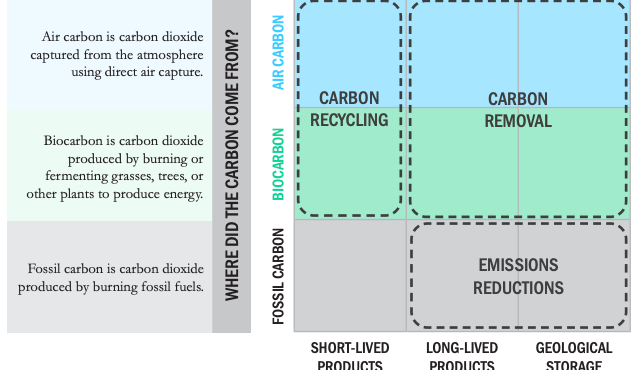The term carbon capture and storage (CCS) has largely given way to carbon capture, utilisation and storage (CCUS). More recently, the climate and energy community is also talking about direct air capture (DAC) and carbon removal. There is overlap between these terms, and confusion – unintended and intended – over what carbon capture technologies can do for climate change.
There are many who dislike the term CCUS – widely used by policymakers and experts – because they say it lumps together two different beasts.

Discover B2B Marketing That Performs
Combine business intelligence and editorial excellence to reach engaged professionals across 36 leading media platforms.
“I hate CCUS,” says Jonas Helseth, director of the EU policy office of Bellona, a Norwegian NGO. “CCS is a climate-only technology. Its only purpose is to avoid dumping CO2 into the atmosphere. CCU is a huge box full of stuff, some of which may be relevant to climate and some of which isn’t. By conflating the two, you kind of greenwash CCU.”

Policymakers are not oblivious to the difference. CCS, but not CCU, has been eligible for public subsidies in the Netherlands since September 2020, when the Dutch expanded their renewables support scheme to other low-carbon technologies. CCS, but not CCU, counts as “green” under a new EU green investment taxonomy.
Carbon flows
The problem with CCU is that how the carbon is used has implications for climate change: it can stay locked up in building materials for decades, but may be stored just a few weeks in fuels like methanol. The hydrogen-based renewable fuels (e-fuels) that are generating such excitement at the moment are at best carbon neutral, not carbon negative, because the carbon in them will be released when they are burned.
CO2 may well be the ultimate feedstock for the chemical industry. Marco Mensink, European Chemical Industry Council
 GlobalData Strategic Intelligence
GlobalData Strategic IntelligenceUS Tariffs are shifting - will you react or anticipate?
Don’t let policy changes catch you off guard. Stay proactive with real-time data and expert analysis.
By GlobalData
The European Commission recognises that CCU can also have very different climate impacts depending on the origin of the CO2 (fossil, air or bio-based). It plans to define where the carbon in e-fuels can come from by the end of 2021. This will be essential input to their business case, alongside legislation about whether and how e-fuel producers can access the grid to produce renewable hydrogen.
E-fuel producers, such as German start-up Sunfire, argue they need access to carbon from point sources – industrial installations – in the beginning because DAC is still too expensive. Using such carbon would not help climate change – it simply “displaces” emissions, as one expert puts it – unless it paves the way to DAC. That would enable carbon neutral e-fuels, if their hydrogen is 100% renewable.
A CCU definition
The Institute for Carbon Removal Law and Policy, a university research centre in Washington, DC, says the key question to ask is: where did the carbon come from and where did it go?
It differentiates between fossil carbon, carbon from biomass and carbon from the air. It also distinguishes between short-lived products whose use will lead to CO2 emissions in less than 100 years (such as synthetic fuels and some industrial chemicals); long-lived products that will store carbon for at least 100 years (like low-carbon cement and various polymers); and geological storage in saline aquifers or depleted oil and gas reservoirs.

The best way of distinguishing between different kinds of CCU is to examine contributions to climate action, rather than getting hung up on different technologies, the centre argued in a paper in December 2020.
Energy system integration
The European chemical industry is embracing CCU in the context of the EU’s push for a “circular economy”.
“We can recycle the carbon in waste gases from the steel sector into bioethanol, or ‘steelanol’ for example,” said Marco Mensink, director general of the European Chemical Industry Council (Cefic), in an interview with Energy Monitor in September 2020. “If you can keep the recycling loop closed and limit its emissions, industrial CO2 can be reused to make climate-neutral chemicals.”
“The battles are moving away from targets and timelines into accounting and definitions.” Jonas Helseth, Bellona
He concluded: “CO2 may well be the ultimate feedstock for the chemical industry.”
In its vision for 2050, Cefic expects fossil fuels to remain the most important source of feedstock for chemicals. Mensink stresses the need for an accounting framework for CCU. “To ensure that it makes a genuine contribution to climate action, policymakers need to spell out what counts as an emission reduction and who in the value chain can lay claim to it,” he says.
Dangerous precedent
Helseth worries about recycling CO2, however, particularly into chemicals. He believes CCU may be a dangerous distraction.
In January 2017, lime producer Schaefer Kalk won a case against the Commission at the European Court of Justice, which ruled that the CO2 it chemically transforms by CCU counts as stored, not emitted.
This ruling could serve as a precedent for other CCU applications – and give the illusion of carbon removal where there is none. The problem is that if such storage is not permanent, the emissions need to be recorded somewhere, says Helseth: “The battles are moving away from targets and timelines into accounting and definitions.”
Scalability
CCU remains niche. Quite a few companies are looking at reusing carbon, either from industrial waste gases or used plastic, but the volumes are not yet there. One polymer producer, Covestro, recycles industrial CO2 into a foam that goes into bed mattresses, for example, but the quantities are small.
The story is similar in other sectors. CCU could, at most, account for just a fifth of the 30–50 million tonnes of CO2 the EU cement industry will need to use or store in 2050, said Rob van der Meer from HeidelbergCement at a conference in Brussels in January 2020.
[Keep up with Energy Monitor: subscribe to our weekly newsletter]
One of the biggest challenges facing CCU is its extreme energy intensity. Paradoxically, this gives it an advantage over CCS in the EU Innovation Fund, fed by the sale of carbon market allowances and potentially worth €10bn from 2020–30, because all electricity generation is assumed to be zero emissions.
From CCU to CCS
However, that electricity still needs to come from somewhere. One of the big questions to answer is: what is the best use of clean power? If a lot of it goes to DAC, does it make sense to store that carbon rather than put it to use? If there is a lot of power going into electrolysis in parallel, does it not make sense to produce e-fuels?
“An energy system question will emerge over the best use of all the energy we produce,” says one carbon removal expert. If the bulk of carbon removal is technological, rather than nature-based, there will be increasing pressure to put that carbon to economic use rather than bury it underground.
Economics has to dovetail with climate action, however. Scientists say carbon removal technologies need to scale up rapidly from 2030 to mop up at least 5Gt a year by 2050. CCU could accelerate their development, even if some uses, like e-fuels, only store carbon temporarily. The key to a constructive role for CCU will be understanding the chemistry, as well as physics, of the energy system.





